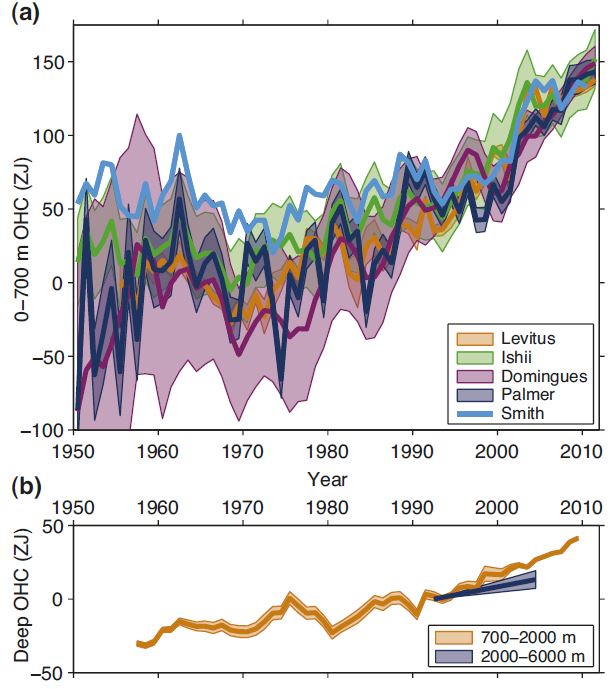Welcome to DU!
The truly grassroots left-of-center political community where regular people, not algorithms, drive the discussions and set the standards.
Join the community:
Create a free account
Support DU (and get rid of ads!):
Become a Star Member
Latest Breaking News
General Discussion
The DU Lounge
All Forums
Issue Forums
Culture Forums
Alliance Forums
Region Forums
Support Forums
Help & Search
Environment & Energy
Related: About this forumReal Climate: Ocean Heat Content Is Extremely Unresponsive To Policy
Last edited Fri Oct 24, 2014, 07:59 AM - Edit history (1)
The New York Times, 12 December 2027: After 12 years of debate and negotiation, kicked off in Paris in 2015, world leaders have finally agreed to ditch the goal of limiting global warming to below 2 °C. Instead, they have agreed to the new goal of limiting global ocean heat content to 10x24 Joules. The decision was widely welcomed by the science and policy communities as a great step forward. “In the past, the 2 °C goal has allowed some governments to pretend that they are taking serious action to mitigate global warming, when in reality they have achieved almost nothing. I’m sure that this can’t happen again with the new 10x24 Joules goal”, said David Victor, a professor of international relations who originally proposed this change back in 2014. And an unnamed senior EU negotiator commented: “Perhaps I shouldn’t say this, but some heads of state had trouble understanding the implications of the 2 °C target; sometimes they even accidentally talked of limiting global warming to 2%. I’m glad that we now have those 10x24 Joules which are much easier to grasp for policy makers and the public.”This fictitious newspaper item is of course absurd and will never become reality, because ocean heat content is unsuited as a climate policy target. Here are three main reasons why.
1. Ocean heat content is extremely unresponsive to policy.

While the increase in global temperature could indeed be stopped within decades by reducing emissions, ocean heat content will continue to increase for at least a thousand years after we have reached zero emissions. Ocean heat content is one of the most inert components of the climate system, second only to the huge ice sheets on Greenland and Antarctica (hopefully at least – if the latter are not more unstable than we think).
EDIT
But it seems clear to me that global mean surface temperature is the one metric that best meets these requirements. It is the one climate variable most clearly linked to radiative forcing, through the planetary energy budget equation. The nearly linear relation of cumulative emissions and global temperature allows one to read the remaining CO2 emissions budget off a graph (Fig. SPM.10 of the AR5 Summary for Policy Makers) once the global temperature target is agreed. Most impacts scale with global temperature, and how a whole variety of climate risks – from declining harvests to the risk of crossing the threshold for irreversible Greenland ice sheet loss – depends on temperature has been thoroughy investigated over the past decades. And finally we have four data sets of global temperature in close agreement (up to ~0.1 °C), natural variability on the relevant time scales is small (also ~0.1 °C) compared to the 2 °C limit, and models reproduce the global temperature evolution over the past 150 years quite well when driven by the known forcings.
I find the arguments made by Victor and Kennel highly self-contradictory. They find global mean temperature too variable to use as a policy target (that is the thrust of their “hiatus” argument) – but they propose much more noisy indicators like an index of extreme events. They think global surface temperature is affected by “all kinds of factors” – and propose ocean heat content, which is determined by the history of surface temperature. Or the surface area in which conditions stray by three standard deviations from the local and seasonal mean temperature, which is a straight function of global surface temperature with some noise added. They argue surface temperature is something which can’t directly be influenced by policy – and propose deep ocean heat content where this is a hundred times worse. They say limiting warming to 2 °C is “effectively unachievable” – and then say “it’s not going to be enough to stop warming at 2 degrees“. I simply cannot see a logically coherent argument in all this.
EDIT
http://www.realclimate.org/index.php/archives/2014/10/ocean-heat-storage-a-particularly-lousy-policy-target/#more-17608
InfoView thread info, including edit history
TrashPut this thread in your Trash Can (My DU » Trash Can)
BookmarkAdd this thread to your Bookmarks (My DU » Bookmarks)
0 replies, 515 views
ShareGet links to this post and/or share on social media
AlertAlert this post for a rule violation
PowersThere are no powers you can use on this post
EditCannot edit other people's posts
ReplyReply to this post
EditCannot edit other people's posts
Rec (3)
ReplyReply to this post